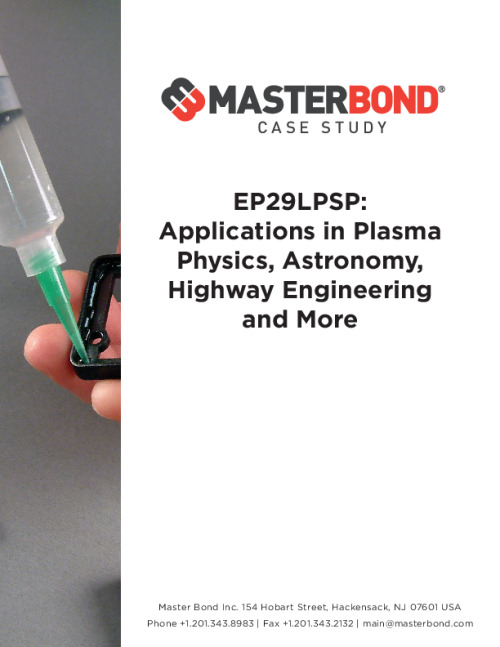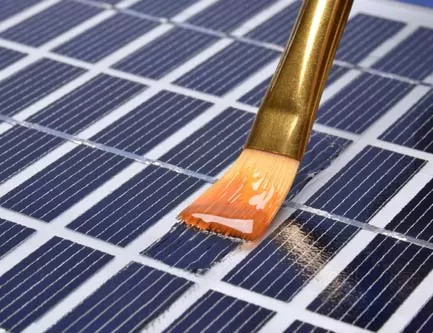Since its introduction in 1978, Master Bond EP29LPSP has been the epoxy compound of choice in a variety of challenging applications. Ideal for demanding cryogenic environments, two-part EP29LPSP can withstand temperatures as low as 4K and can resist cryogenic shock when, for instance, it is cooled from room temperature to cryogenic temperatures within a 5-10 minute window. Optically clear EP29LPSP has superior physical strength, electrical insulation, and chemical resistance properties. It also meets NASA low outgassing requirements and exhibits a low exotherm during cure. This low viscosity compound is easy to apply and bonds well to metals, glass, ceramics, and many different plastics. Curable at room temperature, EP29LPSP attains its best results when cured at 130-165°F for 6-8 hours.
 In over a dozen published research articles, patents, and manufacturers’ specifications, scientists and engineers have identified EP29LPSP for use in their applications due to its unparalleled performance in one or more areas. Table 1 highlights several commercial and research applications that use Master Bond EP29LPSP. Table 2 summarizes several patents that reference EP29LPSP. Following each table are brief descriptions of the role Master Bond EP29LPSP plays in each application or invention.
In over a dozen published research articles, patents, and manufacturers’ specifications, scientists and engineers have identified EP29LPSP for use in their applications due to its unparalleled performance in one or more areas. Table 1 highlights several commercial and research applications that use Master Bond EP29LPSP. Table 2 summarizes several patents that reference EP29LPSP. Following each table are brief descriptions of the role Master Bond EP29LPSP plays in each application or invention.
Table 1: Commercial and Research Uses of EP29LPSP
| Industry | Application | EP29LPSP Use | Critical Properties |
| Plasma Physics | Experimental device to study magnetic reconnection events1 | Fabrication of flux core assemblies | Cryogenic Low outgassing |
| Astronomy | Infrared telescope system2 | Optical fiber mounting assembly | Cryogenic Low outgassing Long cure time Low shrinkage |
| Aeronautics | Testing of a miniature ramjet model in a supersonic wind tunnel4 | Bonding strain gauges to flexure beams | Sufficient flexibility at cryogenic temperatures |
| Particle Physics | Argon detector5 | Coat metal rim to electrically insulate it | Cryogenic Low outgassing Electrical insulation |
| Particle Physics | Radioactive decay detector6 | Bond flexible cable to flange | Low outgassing |
| Neuroscience | Neurophysiological mechanism of magnetic stimulus in primates11 | Mechanism to impregnate mini coil during winding process | Low viscosity impregnation |
| Spacecraft | Attach MLI blanket to spacecraft to survive acceleration, acoustic nd venting loads while minimizing heat load to tank12 | Configuration of a standoff with an MLI blanket | High tensile and shear strength at cryogenic temperatures |
Table 2: Patent Grants that Reference EP29LPSP
| Application | EP29LPSP Use | Critical Properties |
| Cryogenic refrigerator7 | Bond thermally insulated tubes to thermal tube couplers | Cryogenic Low outgassing Thermal shock resistant |
| Proton Exchange Membrane (PEM) fuel cell8 | Rigidizing a fluid flow plate assembly | Electrical insulation Physical strength |
| Structural health monitoring (SHM) system9 | Affix transducers to structure under test | Cryogenic Withstand vibrations |
| Fiber optic gyroscopes10 | Construction of fiber optic sensing coil | Cryogenic Low outgassing |
Conclusion
The success of any engineered product depends on the performance of all of its parts, including any chemical compound used to join or protect one or more parts. If an adhesive, coating, or potting compound fails, the product fails. Leading companies, research labs, and inventors around the world rely on Master Bond EP29LPSP to perform unfailingly in extremely demanding applications.
Sources
1Manufacturing Specification and Statement of Work: FLARE (Facility for Laboratory Reconnection Experiments) Project —Fabrication of Flux Core, FLARE-Spec-03-Rev.00, WP1995, Revision 0, Princeton University Plasma Physics Laboratory, 19 Mar. 2015. https://flare.pppl.gov/Construction/FLARE%20FCSpec-03%2019Mar15.pdf . Accessed September 2023.
2Lee, David, et al. Properties of optical fibres at cryogenic temperatures. Monthly Notices of the Royal Astronomical Society, vol. 326, no. 2, 11 Sept. 2001, pp. 774-780. ResearchGate, doi: 10.1046/j.1365-8711.2001.04630.x. Accessed 2 Aug. 2017.
3 Reference Surfaces for Scanner Calibration Phoenix Scientific Inc., 2002, www.phnx-sci.com/PPS/Downloads_files/AN2002-01%20Ref%20Surface%20for%20…. Accessed 2 Aug. 2017.
4Chen, Bingqiang. Numerical Performance Prediction of a Miniature Ramjet at Mach 4, MS thesis, Naval Postgraduate School, 2012. https://apps.dtic.mil/sti/citations/tr/ADA567441. Accessed September 2023.
5 Xu, Jingke. Study of Argon from Underground Sources for Direct Dark Matter Detection. Dissertation, Princeton University, 2013.
6 Hsu, Scott C. Experimental Study of Ion Heating and Acceleration During Magnetic Reconnection. N.P. June 2000. July 2016. http://www.osti.gov/scitech/servlets/purl/750977
7Snow, David, et al. “Apparatus and methods for improving vibration isolation, thermal dampening, and optical access in cryogenic refrigerators.” US Patent 8,756,941. 24 Jun. 2014.
8Walsh, Michael M. “Fuel cell assembly fluid flow plate having conductive fibers and rigidizing material therein.” US Patent 6,096,450. 1 August 2000.
9 Qing, Xinlin, et al. “Method and apparatus for conducting structural health monitoring in a cryogenic, high vibration environment.” US Patent 8,347,722. 8 January 2013.
10 Chappell, Charles D. and Kara L. Warrensford. “Systems and methods for controlling the gas conversion in a fiber-optic gyroscope.” US Patent 9,182,230. 10 November 2015.
11 Tischler, Hadass. Wolfus, Shuki. Friedman. Alexander. Perel, Eli. Pashut, Tamar. Lavidor, Michal. Alon Korngreen, Alon. Yeshurun, Yosef. Bar-Gad, Izhar. “Mini-coil for magnetic stimulation in the behaving primate.” Bar Ilan University, Ramat Gan, Israel. June 12, 2010. Revised September 28, 2010.
12 Alberts, S.J., Doehne, C.J., and Johnson, W.L. “Testing Tensile and Shear Epoxy Strength at Cryogenic Temperatures.” https://ntrs.nasa.gov/archive/nasa/casi.ntrs.nasa.gov/20170009145.pdf. Accessed May 2020.


